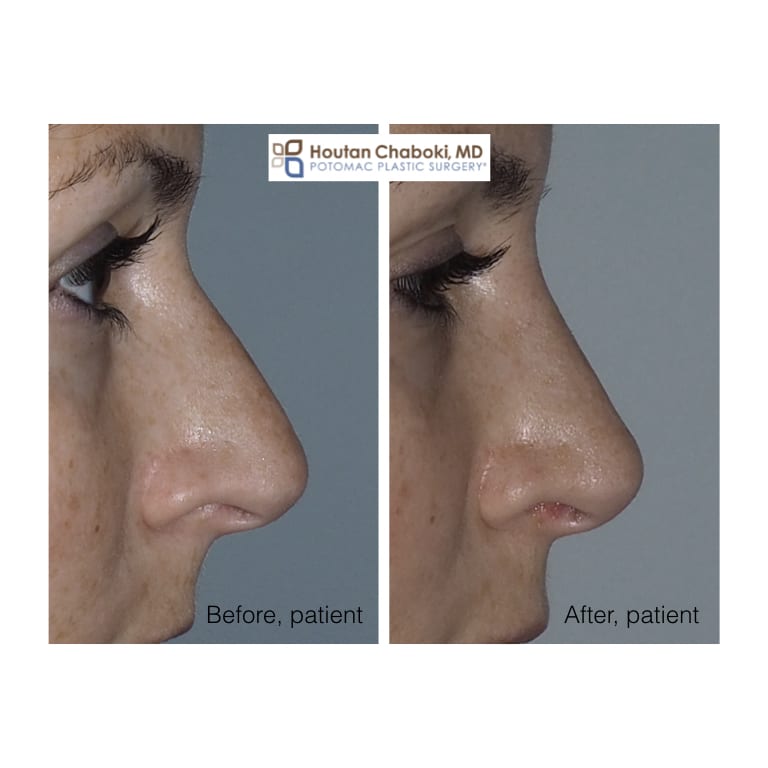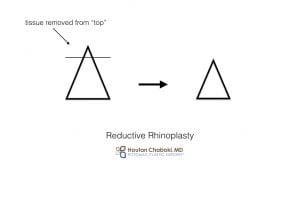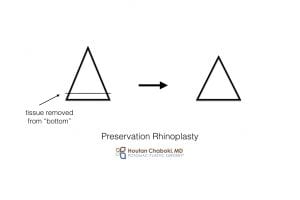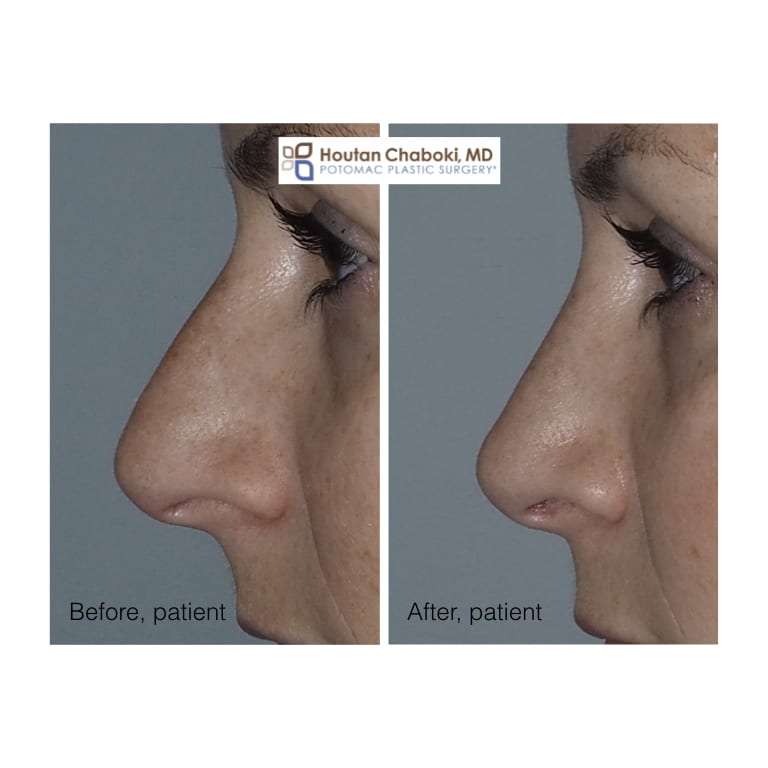
Before and after preservation rhinoplasty via a closed approach to improve the profile and reduce a bump by Dr. Chaboki, a Washington DC rhinoplasty specialist. The tip was also rotated slightly upward. After photograph is several weeks after rhinoplasty.
Nose reshaping or rhinoplasty was the third most popular procedure in 2018, according to plastic surgery data. Breast augmentation and liposuction was more popular. Nose surgery is the most common cosmetic facial surgery, while botulinum (Botox®, Dysport®, and Xeomin®) remains the most common nonsurgical procedure.
Preservation Rhinoplasty to Reduce a Bump
Rhinoplasty surgery to reduce a bump is typically reductive, with plastic surgeons shaving, rasping, or filing down the bump. Another rhinoplasty method is to push down or let down the bump by removing tissue under the bump itself. This alternative method is called preservation rhinoplasty.
A characteristic feature of the preservation rhinoplasty procedure is to preserve the bone and cartilage of the bridge of the nose when reducing a bump. As an analogy, instead of reducing the size of a tower by removing the top, the size of the tower is reduce by reducing the feet and settling in down. One potential benefit of preservation rhinoplasty is a smoother and more natural bridge during hump reduction.


Plastic Surgeons who Specialize in Preservation Rhinoplasty
Rhinoplasty is considered the most difficult cosmetic surgery by plastic surgeons. Closed rhinoplasty, also known as endonasal, modifies nasal bone and cartilage without any external incisions.
Closed rhinoplasty is more difficult to learn by plastic surgeons, and closed preservation rhinoplasty has an even higher learning curve for some surgeons. Dr. Chaboki is one of a few select rhinoplasty specialists in the US who perform this type of nasal surgery.
A majority of rhinoplasty surgeons in the US perform reductive rhinoplasty via an open approach, making an external scar and filing down the bump. Open rhinoplasty is easier to learn for plastic surgeons as one has a wide, open view of the bone and cartilage. As a result, fewer surgeons perform closed rhinoplasty, which avoids an external scar and has less swelling compared to the open. It’s our understanding that only a handful of US rhinoplasty surgeons perform closed preservation rhinoplasty due to its technical challenges and difficulty learning for the surgeon.

Before and after preservation rhinoplasty via a closed approach to improve the profile and reduce a bump by Dr. Chaboki, a Washington DC rhinoplasty specialist. The tip was also rotated slightly upward. After photograph is several weeks after rhinoplasty.
Preservation Rhinoplasty Benefits
While closed rhinoplasty is more difficult to learn for plastic surgeons, closed preservation rhinoplasty has many benefits for the patient. Bone and soft tissue anatomy is left intact as much as possible with preservation rhinoplasty. Swelling can be reduced with preservation of the bridge. Some plastic surgeons also maintain the skin attachment on the bump to allow even faster recovery.
Rhinoplasty patients with a bump are often good candidates for this advanced rhinoplasty technique. Patients with thin skin are especially good candidates for preservation rhinoplasty as the long-term results tend to be much smoother as compared to traditional reductive techniques.
Preservation Rhinoplasty Video
Dr. Chaboki performs preservation rhinoplasty via a closed, endonasal approach to reduce a bump for this patient. External incisions or scars are not used with the closed approach. Dr. Chaboki is pushing down the bump to improve the profile for natural results.
Considering nose reshaping to reduce a bump? Contact the office to see if you’re a candidate for preservation rhinoplasty.

thank you for this post. Its very inspiring.
Thank you for reading our blog about preservation rhinoplasty.
Best,
Dr. Chaboki
I have always been insecure about my nose, which is why I’m thinking of rhinoplasty surgery since this will help give my nose a better shape. Well, thank you for also elaborating here that it’s procedure will preserve the nose’s bone and cartilage. It’s also good to know that swelling will be reduced with the preservation of the bridge.
Hello, i wanted to ask about the pricings for a rhinoplasty.
General plastic surgery pricing can be found on our website here.